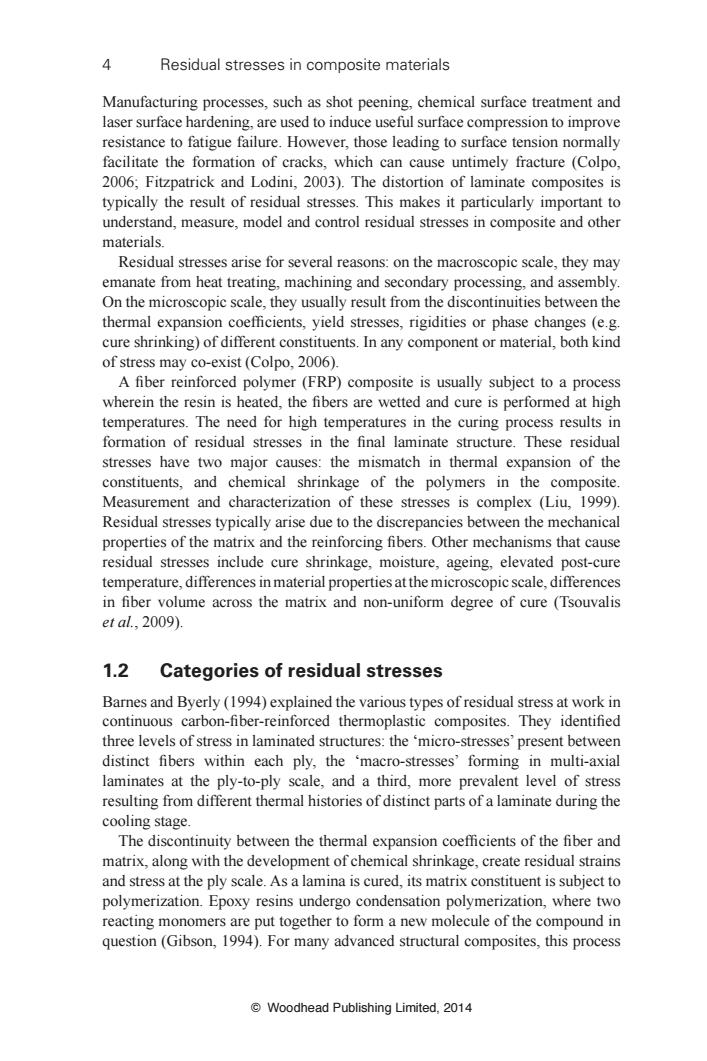正在加载图片...

4 Residual stresses in composite materials Manufacturing processes,such as shot peening,chemical surface treatment and laser surface hardening,are used to induce useful surface compression to improve resistance to fatigue failure.However,those leading to surface tension normally facilitate the formation of cracks,which can cause untimely fracture (Colpo, 2006;Fitzpatrick and Lodini,2003).The distortion of laminate composites is typically the result of residual stresses.This makes it particularly important to understand,measure,model and control residual stresses in composite and other materials. Residual stresses arise for several reasons:on the macroscopic scale,they may emanate from heat treating,machining and secondary processing,and assembly. On the microscopic scale,they usually result from the discontinuities between the thermal expansion coefficients,yield stresses,rigidities or phase changes (e.g cure shrinking)of different constituents.In any component or material,both kind of stress may co-exist (Colpo,2006). A fiber reinforced polymer(FRP)composite is usually subject to a process wherein the resin is heated,the fibers are wetted and cure is performed at high temperatures.The need for high temperatures in the curing process results in formation of residual stresses in the final laminate structure.These residual stresses have two major causes:the mismatch in thermal expansion of the constituents,and chemical shrinkage of the polymers in the composite. Measurement and characterization of these stresses is complex (Liu,1999). Residual stresses typically arise due to the discrepancies between the mechanical properties of the matrix and the reinforcing fibers.Other mechanisms that cause residual stresses include cure shrinkage,moisture,ageing,elevated post-cure temperature,differences in material properties at the microscopic scale,differences in fiber volume across the matrix and non-uniform degree of cure (Tsouvalis etal.,2009). 1.2 Categories of residual stresses Barnes and Byerly(1994)explained the various types of residual stress at work in continuous carbon-fiber-reinforced thermoplastic composites.They identified three levels of stress in laminated structures:the 'micro-stresses'present between distinct fibers within each ply,the 'macro-stresses'forming in multi-axial laminates at the ply-to-ply scale,and a third,more prevalent level of stress resulting from different thermal histories of distinct parts of a laminate during the cooling stage. The discontinuity between the thermal expansion coefficients of the fiber and matrix,along with the development of chemical shrinkage,create residual strains and stress at the ply scale.As a lamina is cured,its matrix constituent is subject to polymerization.Epoxy resins undergo condensation polymerization,where two reacting monomers are put together to form a new molecule of the compound in question (Gibson,1994).For many advanced structural composites,this process Woodhead Publishing Limited,20144 Residual stresses in composite materials © Woodhead Publishing Limited, 2014 Manufacturing processes, such as shot peening, chemical surface treatment and laser surface hardening, are used to induce useful surface compression to improve resistance to fatigue failure. However, those leading to surface tension normally facilitate the formation of cracks, which can cause untimely fracture (Colpo, 2006; Fitzpatrick and Lodini, 2003). The distortion of laminate composites is typically the result of residual stresses. This makes it particularly important to understand, measure, model and control residual stresses in composite and other materials. Residual stresses arise for several reasons: on the macroscopic scale, they may emanate from heat treating, machining and secondary processing, and assembly. On the microscopic scale, they usually result from the discontinuities between the thermal expansion coeffi cients, yield stresses, rigidities or phase changes (e.g. cure shrinking) of different constituents. In any component or material, both kind of stress may co- exist (Colpo, 2006). A fi ber reinforced polymer (FRP) composite is usually subject to a process wherein the resin is heated, the fi bers are wetted and cure is performed at high temperatures. The need for high temperatures in the curing process results in formation of residual stresses in the fi nal laminate structure. These residual stresses have two major causes: the mismatch in thermal expansion of the constituents, and chemical shrinkage of the polymers in the composite. Measurement and characterization of these stresses is complex (Liu, 1999). Residual stresses typically arise due to the discrepancies between the mechanical properties of the matrix and the reinforcing fi bers. Other mechanisms that cause residual stresses include cure shrinkage, moisture, ageing, elevated post- cure temperature, differences in material properties at the microscopic scale, differences in fi ber volume across the matrix and non- uniform degree of cure (Tsouvalis et al. , 2009). 1.2 Categories of residual stresses Barnes and Byerly (1994) explained the various types of residual stress at work in continuous carbon- fi ber-reinforced thermoplastic composites. They identifi ed three levels of stress in laminated structures: the ‘micro- stresses’ present between distinct fi bers within each ply, the ‘macro- stresses’ forming in multi- axial laminates at the ply- to-ply scale, and a third, more prevalent level of stress resulting from different thermal histories of distinct parts of a laminate during the cooling stage. The discontinuity between the thermal expansion coeffi cients of the fi ber and matrix, along with the development of chemical shrinkage, create residual strains and stress at the ply scale. As a lamina is cured, its matrix constituent is subject to polymerization. Epoxy resins undergo condensation polymerization, where two reacting monomers are put together to form a new molecule of the compound in question (Gibson, 1994). For many advanced structural composites, this process